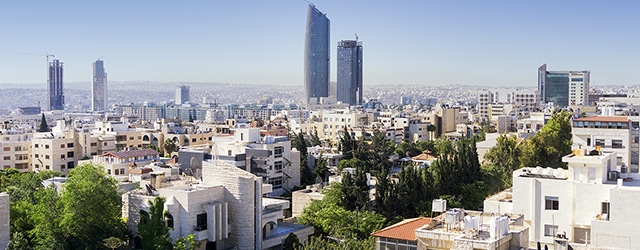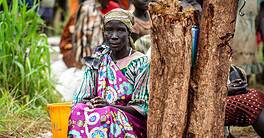Levantine banks operate in fragile economies in a region facing severe upheaval. Some are finding a way through the chaos better than others.

Lately, The Levant countries have seen some troublesome times: demonstrations, war, rising debt and concerns about government spending. Such negatives often send investors scuttling for the exit.
But the Levant, a nebulously defined area of the eastern Mediterranean spreading from Egypt in the west to Jordan, Syria, Lebanon and Israel in the east, is showing remarkable resilience as individual countries take up policies to strengthen their economies. Egypt’s economy is already showing renewed promise. Meanwhile, Lebanon has a steady hand at the helm of its central bank and tourism is booming in Jordan. Syria, however, looks likely to remain stressed for some time.
These countries share a colonial past, with Turkey and then France and the UK variously in charge until they all became independent after the Second World War. Cities like Beirut, Alexandria and Cairo were polyglot, multicultural places. Today these cities and their region desperately need reforms to encourage investment, stimulate growth and garner the support of the wider world, and some of them are taking active steps to improve the business environment and bolster their appeal to foreign investors.
Egypt is at a crossroads after widespread protests in September revealed popular dissatisfaction with living conditions, widespread corruption and authoritarian rule. The protests have largely abated; but close observers expect a new focus on improving living standards will come at the expense of much-needed structural and other reforms and weaken Cairo in the eyes of investors.
“I suspect the authorities will look closely at the economic reform program, since they know now so many people are unhappy,” says Ayham Kamel, head of Eurasia Group’s Middle East and North Africa research team. “We will probably see more money directed to social spending to reduce tensions, though this will impact fiscal adjustment.”
The International Monetary Fund (IMF), however, reckons Egypt’s economy has turned the corner, having signed off in July on the end of its three-year, $12 billion support package. GDP growth is expected to be about 5.5% this fiscal year, rising to near 6% next year, and is sustainable, the IMF says. Inflation is down to 13.9%, the IMF says, after hitting a 30-year high of 23.5% in 2017; unemployment is below 10% and public debt is falling along with the budget deficit.
Interest rates have been cut three times this year on the back of lower inflation and a recovery in the Egyptian pound, heavily devalued in 2016. The discount rate stands at 13.75%, with further reductions expected. Large-scale cuts in subsidies have led to fuel-price rises and have pushed down Egypt’s debt-to-GDP ratio, which peaked at 103% but is now around 90% and falling. Another positive is the ongoing development of the country’s gas reserves, which have turned Egypt into an energy exporter and encouraged large-scale foreign direct investment into the sector.
Two priorities, the IMF says, are “to cement the hard-won gains in stabilizing the economy [and] to accelerate reforms to unleash the economy’s potential, making the private sector the engine of growth.” Cairo faces the daunting challenge of creating 700,000 new jobs annually for its fast-growing population.
Noting that the government restored costly subsidies to some 2 million people in the wake of September’s protests, James Swanston, Middle East analyst at Capital Economics, warns of the risks of further fiscal weakening. “This would put debt back on an upward trajectory and raise the risk of a fresh buildup of macro imbalances,” he posted in October on the company’s Middle East Economics blog.
Egypt’s economy is expected to rebound further as cheaper credit feeds into both capital and consumer spending; Moody’s suggested in September that credit growth next year could rise 15%. At the same time, government spending is proceeding with the construction of new government and other buildings in New Cairo and New Alamein, with some government departments expected to take up residence in the former later this year or early next.
For many analysts, however, the fear is that the government, anticipating GDP growth to continue at around 5% over the next few years, would take its eyes off longer-term structural priorities.
“We’ve been very impressed by the pace of reform, which explains our March decision to upgrade Egypt to B+ with a stable outlook,” says Jan Friederich, head of Middle East and Africa sovereign ratings at Fitch Ratings. “But Egyptians have experienced a lot of austerity, and the risk of reform fatigue is very present.”
Infrastructure is in need of upgrading. The Cairo metro, built in the 1980s when the population was less than 10 million, is now creaking at the seams as the city’s population has swollen to over 20 million.
“The needs are huge and we look forward to next year’s planned IPO program, which should cover most areas of the economy, including finance, and boost overall investment,” says Janet Heckman, managing director for the Southern and Eastern Mediterranean region at the European Bank for Reconstruction and Development (EBRD), which has invested €5.2 billion ($5.8 billion) in Egypt since 2009, making it the EBRD’s largest country of operation.
Other priorities include more accommodations to business, such as reducing corruption and improving access to land—much of which is held by the military. “The biggest worries about the military’s involvement in the economy are that it is corrosive, unaccountable and extensive, accounting perhaps for as much as 30% to 40% of GDP,” says David Butter, associate fellow with Chatham House’s Middle East and North Africa Programme. “It also crowds out the private sector, which is more efficient and more transparent.”
In Lebanon, Prime Minister Saad Hariri has declared an “economic state of emergency,” calling for reduction of deficits while maintaining the US dollar currency peg. Most observers expect GDP, which has grown only feebly for the past five years, to stall this year.
External debt, currently among the world’s highest at more than 190% of GDP, looks set to grow further. This would worsen problems for Lebanon’s banks, which have until now been the country’s lifeblood, attracting deposits from home and abroad and supporting government spending. In August, Fitch Ratings downgraded Lebanon’s sovereign rating from B- to CCC, warning that with external financing needs now at 24% of GDP, the situation is increasingly unsustainable.
On the plus side, the Banque du Liban (BdL), headed for more than 26 years by Riad Salamé, has foreign exchange reserves holding steady at around $37 billion—more than enough to fund imports in a very consumption- and import-focused economy—and maintain the 22-year-old peg of 1,507.5 Lebanese pounds to the dollar.
Recent figures, however, show a slowing in nonresident deposits in Lebanon’s banks, possibly due to investor worries about excessive public sector spending—including vast subsidies to Electricite du Liban, the state electricity entity—huge debt-servicing costs and the absence of economic growth. Reports of dollar shortages are becoming more frequent, as are protests against bank moves to curtail and limit dollar withdrawals.
Close observers worry that if current depositor trends continue, eventually the BdL will have to choose between maintaining the peg and keeping reserves at or near their current rate.
Long-term, a flexible exchange rate may prove to be a more pragmatic policy and it certainly would take pressure off the BdL, but the challenge would be how to get there. A sudden collapse of the existing peg would push many businesses and individuals to the brink. Unsurprisingly perhaps, Beirut’s stock market has lost almost one quarter of its value this year, as investors decided to hold back until conditions stabilize.
“The political classes have put off serious decision-making for so long that the country now faces serious choices,” says Eurasia Group’s Kamel. “Traditional allies like France and Saudi Arabia are pretty much saying they’ve done all they can. Things are on a definite negative trajectory.” At the least, Kamel says Lebanon faces a serious fiscal adjustment at a time when the economy is already in contraction.
The timing is not good in geopolitical terms either. Traditional Gulf allies are preoccupied with their own concerns: Many are themselves in recession. The fact that Hezbollah, a close ally of Iran hated by Riyadh and Abu Dhabi, is becoming more powerful within Lebanon’s power-sharing elite further encourages Gulf governments to hold back from their traditional support for Beirut. Jason Tuvey, a senior emerging markets economist at Capital Economics, specializing in the Middle East and North Africa, warns in a September post on the company blog that in the event of a war between Iran and the US, supported by Saudi Arabia, investors would take flight, eventually precipitating “a messy sovereign default.”
Because “local banks are the largest holders of government debt … a default would probably result in severe strains in Lebanon’s financial system,” writes Tuvey.
Jordan Grows, Syria Shrinks
Perhaps the most surprising thing about Jordan is that GDP is expected to grow by 2.2% this year and 2.4% next as the country reaps dividends from investing in its IT industry; in tourism, which is booming; and in renewable, particularly solar, energy. But the strains from having to accommodate close to a million refugees, mostly from the wars in Syria, Iraq and Yemen—almost 10% of the population—and the loss of traditional trade links with those neighboring trade partners, put it at a disadvantage.
“Given Jordan’s potential and its needs—including 19% unemployment—this growth rate simply isn’t enough,” says the EBRD’s Heckman.
Next door in Syria, things are of course very much worse, even without the ongoing conflicts there. GDP is now just $15 billion, or a quarter of its preconflict size, with over 80% of people living below the poverty line in an economy defined by gross corruption and nepotism. This and the virtual elimination of the middle class suggest the prospects for recovery or for new SMEs emerging to support growth and reconstruction are slim. As long as the Assad regime remains in power, outside support will be limited—except from Russia, which is unpredictable and preoccupied with its own domestic concerns.
For Heckman, the lessons are clear. She says other countries should follow Egypt’s lead and find the courage to implement similar far-reaching structural-reform programs, relying on the support of international financial institutions and the international community.
“The Levant is one of the world’s least economically integrated regions,” Heckman says. “The countries need to trade and invest more with each other. The ensuing economic benefits will go a long way to assuaging longstanding social and political problems and reducing tensions.”



